We are closed from the 8th of July, till the 14th of July.
Any orders or questions after the 7th will be seen to from the 14th when we reopen!
---
Thank you for your patronage and understanding.
We are offfering a 15% discount on all DFX Neons pots with the discount code: SummerVibes
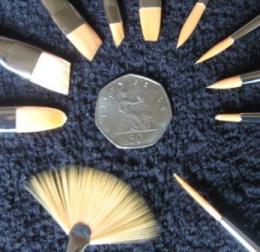
Sep 1, 2021
HOW TO CHOOSE YOUR BRUSH
Every painter feels like a kid in a sweetie shop when they see an array of brushes to choose from, but they can be expensive and it can be difficult to know which flavours you will like!
If you look after them well, your brushes should last for years and become your best friends.
Brushes come in 3 shapes at the base: flat, round and oval. This is the shape of the top end of the ‘ferrule’ - the metal part that holds the hair and is affixed to the wooden or plastic handle. Then there is the manufactured shape of the brush head - mostly pointed, flat or rounded, and the quality of the hair, and whether it is natural or synthetic.
Synthetic brushes come in a wide range of qualities with different ‘spring’ and longevity. Some brushes that are perfect when they are new quickly go ‘hairy’ where the fibres separate or curl and won’t go back to the original shape. I’ve experienced this with a favourite white Taklon, one of the popular cheaper synthetic fibres that we don't sell!
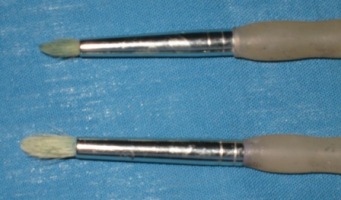
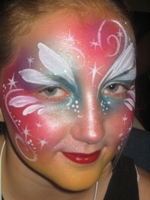
Some are better at keeping their ‘point’ than
others, however, I purposely keep several old round brushes that have long since lost their point for making marks that have a rounded end, in particular
a Paradise Medium Round for my fairy wings! Don’t give up on a dead brush straight away, see if there is something else it will do!
Cheap or inferior brushes can loose their hairs, lose their spring, fall off the handle and generally not survive the rigours of painting and being transported. Some also lose the paint from the handle, not a complete disaster as you can over-paint with nail varnish, but finding bits of flaky paint in your paint is annoying.
Facepaint UK have selected the daVinci Nova range as top of the range synthetics, they are long lasting, stay in one piece and keep their form well. These come in round, flat, filbert (rounded flat end), fan and angle, and we do them in useful sets. The daVinci Junior range is acceptable as a budget price brush, the coloured ferrules are fun and easy to spot when you are busy, but you really do get what you pay for, I feel they are ‘sluggish’ after time.
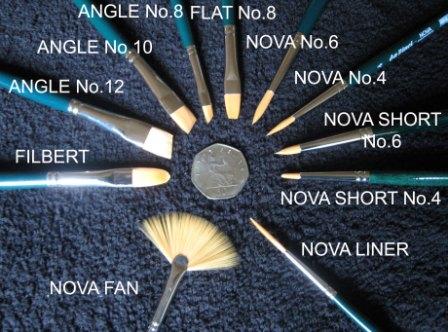

THE NOVA RANGE
Our Professional Set is made up of 15 Nova heads on smart acrylic handles, and look the business! They are nice to hold, and stay clean and shiny looking with no paint to peel off!
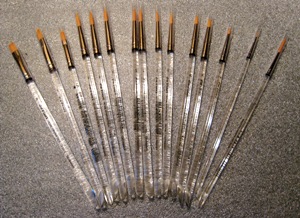
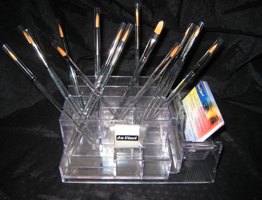
DaVinci are proud makers of excellent brushes. The hairs are set deeper into the ferrule for a longer lasting, more elastic brush as detailed here:
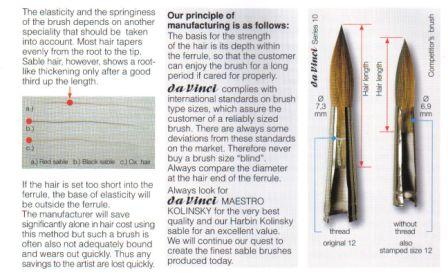
We also stock the Grimas S range of synthetics, the S2, a small round, is one of our most popular brushes for fine lines and dots. Grimas recently changed the shape slightly and made it more pointed, better for some, but not for dotty dotters! However, over time they start to behave themselves like the ‘old’ S2. The SL6 is a flat brush with a pointed filbert end and is brilliant for making teeth on skulls in one print. The SV6 is a small tapered round ended flat brush that isn’t very interesting, but happens to make good leopard spots, and the S6 is a tapered flat end.
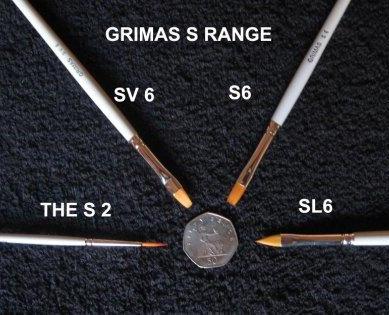
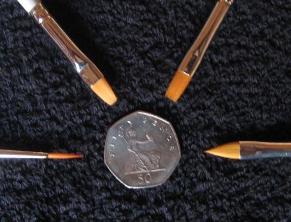
Tha Paradise range has been developed by Jinny, and has some very nice brushes, but there is a tendency for them to fall off the handles, annoying, but they can be glued back on should this happen.
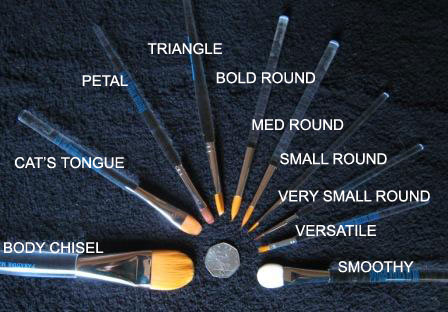
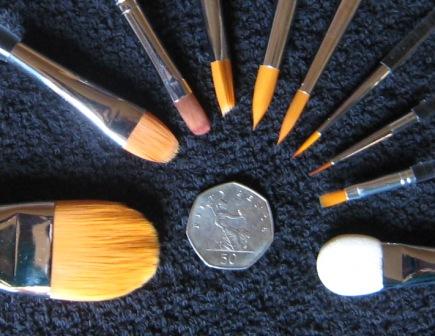
So, having found a good quality synthetic brand, what next? The length in relation to the width is the next thing to look at. A long brush head will make more flowing lines and respond to pressure for the ‘lift and press’ technique. A No.6 is probably the most useful and largest size you would need to go for facepainting, and a No.4 is also handy. If you are blending from a line, a No.6 is essential, you need a broad enough and wet enough line to take your paint from without going over the edge.
A short brush head will make good petal shapes. They won’t hold as much paint as the longer version, but should hold enough for one or two flowers. The width will dictate the size of your petals, but if you have perfected your technique you can make small flowers with a big brush, just don’t press as firmly. However, for speed and certainty it is worth having a small and a large petal brush. Because the brush is firm, you get the nice change in depth of colour with the centre being lighter than the outside because this is where the pressure is greatest, and the paint pushed to the side. This is less easy to achieve with a sable brush. We have Funky Foxes as well as Nova brushes for great petal shapes. You can also make nice petals with filbert shaped brushes used on their sides. It’s not impossible with a longer round or even a flat brush, but why make life more difficult than it need be?
Synthetic brushes are best for the ‘flick’ techniques. This is where the spring comes into its own, they are more controllable than softer natural hair brushes, and less likely to go ‘off piste’ due to the contours of the face, or meeting eyebrows etc.
Sizes range from big to incredibly small, I see no reason for a face painter to buy anything smaller than a No.2, anything less than that won’t be seen from 5 paces, you would be wasting your valuable time as well as your hard earned money!
Natural Hair
The best natural hair brushes are made from Kolinsky sable. Make no mistake, these are harvested from an animal called
a sable, closely related to the weasel and prized for their fur. All natural hair brushes are derived from animals, and they do not get a trim and
blow dry!



However, sable brushes are a delight to use, and once you have made friends with them, there is no going back. They are excellent at holding paint,
so you can paint more per load, and retain their fine point. It is important to look after your expensive brushes and treat them kindly. This way they
will last for years.
The various names of Kolinsky (Marder, Harbin etc) relate to the region that they come from, and the cost relates to how cold it is! The quality of the hair depends on region, gender and which bit of the fur is used, male winter tails from the coldest areas being supreme. There are many, many brands of sable available, we have selected daVinci because their standards in manufacture are consistently high. You can also get a hybrid mix of sable and synthetic which is interesting. Squirrel hair is widely available as a watercolour brush, but is too soft for controlling well for face painting techniques. Ox hair is crude, and not recommended for anything except as a cheap applicator for creams etc. Hog hair is too stiff and scratchy for face painting. Pony hair is used for blusher brushes and fluffs up nicely.
Facepaint UK stocks daVinci and Grimas sable brushes, both are good quality, and have a range of shapes to suit every application. This is the daVinci range that we have carefully selected:
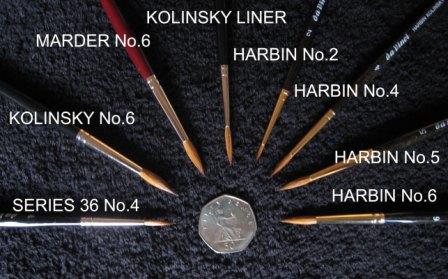
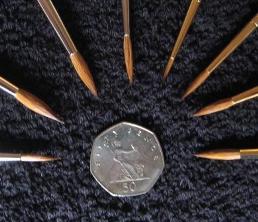
The daVinci Harbin Kolinsky is probably the most popular, and size 6 the most useful. Because they have a fine point the most delicate work as well as a nice broad line is possible. Their potential for a varied line depending on pressure applied and subtle response to the slightest movement makes them the Ferrari’s of the brush world. They are supple enough to change direction and will perform consistently well. The Pure Kolinsky is the Rolls Royce of brushes on offer, but this can be overloaded quite easily, and is fatter in use than the corresponding size of Harbin Kolinsky, it’s best to get used to the Harbin first. The Series 36 is a very good slightly lower priced Kolinsky sable, we have these in our sable sets and the No.4 is a popular addition to the Member’s gift pack. Grimas do a very useful No.6 round, the MR6 it can be used both for line work and petals, and the L4, a flat pointed brush designed to be a lip brush for make-up, is an excellent small petal brush. This is the Grimas range of sable brushes:
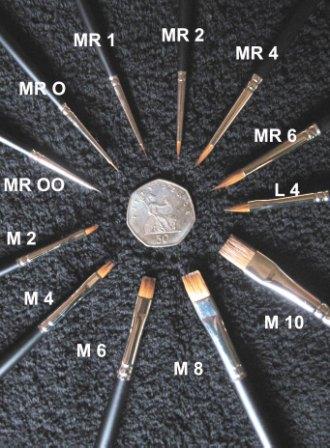
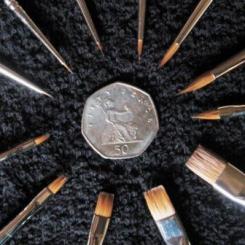
GRIMAS SABLE M RANGE
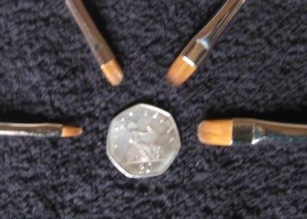
GRIMAS SABLE V RANGE
Every painter you speak to will have their own favourite brush that they can’t live without; sometimes they don’t even know what it is, just that it does
it for them! Equally there is a very good painter that I’ve known for an embarrassingly long time who mistreats her brushes badly, only has about 3
to choose from and it is testimony to her ability that she manages to get the remarkably good results that she does out of a few bent hairs on a stick.
A bad workwoman blames her tools; a good workwoman will manage with almost anything!
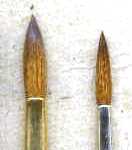
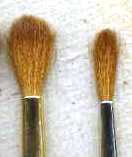
If you look at the difference between wet and dry sable brushes, you will see that there is a big difference, and you can only understand what you have when you are using it.
Special trick brushes! There are several brushes that are either manufactured to do special tricks, or we have found that special tricks can be performed!
Multi Liner – these are sometimes called rake brushes, and there are several different types. Some have a gap between groups of hairs, some have longer hairs above the general body of the brush, and we have the ingenious daVinci version. These are made from 2 different type of fibre, one soft, one stiff. The soft one forms the body of the brush, and the stiffer longer ones rise above. This means that you can either load the brush with paint as a reservoir, or use the fibres to drag from a wet line. These come in 2 sizes of flat ended brushes, and a fan brush.
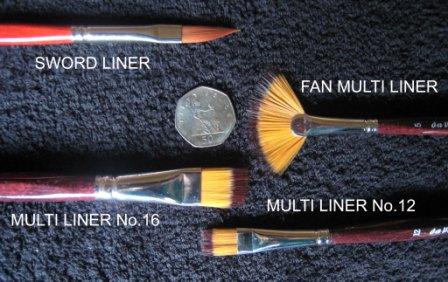
DA VINCI SPECIALS
Sword Liner
There was much excitement in the face painting world when Lynne Jamieson introduced this brush to us. We couldn’t find well made ones in the UK,
so we asked daVinci to make one for us! They are carefully hand made synthetics that form a razor sharp edge when loaded correctly and can paint
the finest possible long line, transferring into a broad stroke if required. They only some in one size as you can do just about everything with
it, the final point is very fine so acts the same as using a smaller brush.
Filbert
These are tongue shaped brushes, sometimes with a point just like a filbert (hazel nut), especially in sables as the Grimas L4, but more often
rounded. They are also sometimes called a cat’s tongue. The shape can be broad or narrow, the Nova filbert is quite narrow, the Paradise Chisel
(in 2 sizes) is quite broad. The two smaller daVinci Cat’s Tongues are an expensive delight, they are manufactured as foundation brushes, but perform
very well for broad strokes, especially useful for body painting where a bigger canvas is in play. The Huge daVinci Cat’s Tongue brush is excellent
at covering a whole body quickly, an investment worth making for the seasoned body painter.
The Grimas SV6 is a filbert and the Sable V Range are all soft ended brushes intended for applying dry shadows, but can also be used wet. The number relates to the mm width.
Fan Brushes
As the name implies, these come in a fan shape and are useful for making lots of small strokes from the separated fibres. The angle that you place
the brush will affect the mark that is made; try different angles from almost flat to right angles to the surface. We have Nova or Multi Liner
versions, the Nova will have a softer effect. These brushes are sometimes cut into a butterfly shape for quick and easy little butterflies, for
this you must simply place the brush, loaded with 2 or 3 colours, flat to the surface without dragging it at all, then flip it over and do the
same with the other side to mirror your first impression.
Liners
These are long thin brushes that come into their own for long flowing lines. The sable is more flexible and pointed than the synthetic, so will
do tighter turns where the synthetic might be inclined to flick out. The angle that the brush is held is important, allow for some flex and don’t
try to use the length of the brush all at once. Some people like to use the synthetic liner for dots as the brush can hold and release a lot of
paint.
Sponge Applicators
These are great for blending used dry, or you can use them wet for nice smudgy marks. The Paradise Cat’s Tongue gets into the inside of the eye
well, and forms the beginning of a neat butterfly. The Grimas sponge tips are replaceable on the standard handle. Our new pointed sponge tips are
great for making larger dots, the size is dependent on the pressure applied. If you are really clever (or lucky) you can make really nice small
bubbles by loading with white paint and pressing harder than usual.
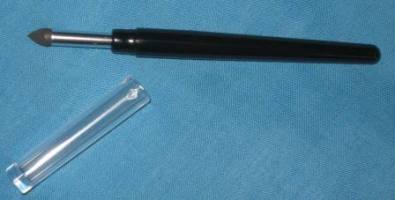
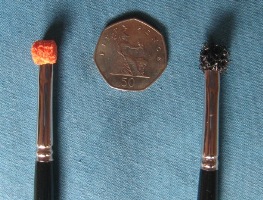
These are two interesting Kryolan sponge tip brushes. The orange one is a rubber based material that is good for picking up a small amount of glitter and placing it exactly where you want it! It will also make interesting little patterns. The black stipple sponge applicator will make a controlled stipple effect in small areas where using a whole stipple sponge might be overkill.
Triangle Brush
This was an addition to the Paradise range that left us all a bit confused. However, you can do some interesting things with its capacity for loading
with 3 colours at once. (Now discontinued) More about this here:
Powder Brush
These Grimas Pony Hair brushes are a beautifully made standard blusher brush with a long handle. They are useful for applying powders, either standard
blushers or eyeshadow colours and iridescent powders over normal paint, or even glitter, but make sure there is none left behind in the hairs if you
want to go back to using it for blush.
Striper
Whilst this little darling may seem expensive, the price compares well to other ‘graining’ brushes. Designed for wood grain special effects, we
have discovered that they also paint tartan and consistent parallel lines. More useful for body painting as you need a broad canvas, though we’ve
seen it used to paint music staves across the face!
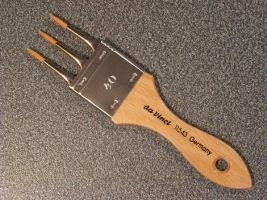
Body brushes
You need bigger brushes for bigger areas. Sponges aren’t always the best tool for covering large areas, so we have a selection of brushes that
address this: the Nova Body Brush is flat ended to achieve good clean blocking out , the Paradise Body Chisel round ended which is better for blending
out for even coverage, as is the daVinci Large Cat’s Tongue. The Huge version has stiffer fibres, a snazzy (and expensive) short acrylic handle
and works a dream on large areas.
Black and white
For black and white in particular it is worth making a hole in your paint just for mixing, and to have the larger size pot to do this. If you are
mixing on the paint, it will just get thicker and thicker rather than form the creamy consistency that you want. This has been variously described
an ‘Indian ink’ and ‘thin cream’ but the bottom line is you need to it be whatever works! If it’s too thick it will be claggy, if it is too runny
it will either drip or be transparent. It’s a good idea to have a ‘puddle’ of mixed paint and water to refill from, it’s not wasteful, the worst
that can happen is it will dry out. Add water to your paint by picking it up by dipping into your water pot with your brush. Some people spray
their paints, but this can result in a puddle of water that you later pick up on your sponge and causes problems with loading that evenly. A gentle
spray of water can work wonders though, it keeps your paints malleable and makes them all look bright and shiny.
Choosing the right brush for the job
This might sound obvious, but it seems it’s not! If you want to make a small mark, use a small brush, if you want a big mark, choose a bigger brush.
That said, the next decision is what kind of mark do you want to make? Do you want to have total control, or are you prepared to let go a little
and work with the brush for perfect symbiosis? In general synthetics give you better control, but hold less paint and sables hold more paint and
have a life of their own.
Loading the brush
This is important for three reasons. One, you won’t get good results if your brush isn’t loaded properly. You need enough paint of the right consistency
to do what you want. Two, if it’s not correctly loaded you will need to keep reloading and this takes time which we never have much of. Three,
be gentle when you load, swirl the brush round the paint, or make gentle back and forward strokes so that you don't spoil the hairs and this also
helps to load evenly.
Never jab your brush into the paint, use sweeping movements that respect the direction of the hair, the same as when you are painting. If you want your brush to have a point, give it a little twist as you finish loading, if you want a flatter end, finish with a flat stroke.
For lines your brush needs to be loaded at least halfway up the brush so that you have a reservoir of paint to draw from. For dots you can load all the way, but it needs to be of the right consistency to leave a drop of paint behind, rather than actually painting the dot. Different brands of paint have different qualities, the most difficult being Wolfe Brothers’ that will run readily or be sticky if it’s not ‘just right’. However, when it is just right, it’s perfect, so worth the bother. Think 3 bears and go for Baby Bear. Go Goldilocks, you had the right idea, but breaking into other people’s houses is not advisable.
So, now you have a well loaded, correct size good quality brush and you’re ready to go.
Painting Techniques
The big mystery! This is difficult to write about, and we spend a lot of hands on time on this at The London School of Facepainting. The two techniques
that present the most difficulties are printing techniques such as petals, and varied thickness stroked lines with a nice beginning and end.
For petals it is important to start with the brush at right angles to the skin, even though it looks like the brush is exactly the right shape to make a petal on its side. If you’re very lucky it will. If you didn’t say the right prayers, it won’t. But if you put the tip down and press downwards, a beautiful petal shape will emerge and if you still have luck on your side, the middle of it will be really interesting. You can then get really clever and ‘double dip’ the tip into another colour (probably best to have sprayed this first) to get a 2 colour effect. When it goes right, you will want to tell the world about it!
For luscious lines, you again need to start with a nicely loaded brush. This will mean that you can still see the original shape of the brush, the paint hasn’t taken over, if it has it’s too thick so you need to add more water and mix again. Start with the brush at 45 degrees to the skin so that the tip is on its side and leaving a nice shape behind. Practice this on you arm. Travel along in the direction of the hairs, if you go sideways, you will ‘skid’ and lose control. To achieve a thinner line gently lift the brush. You can do this at the end of the line, or several times along it. If you want a nice point at the end of the line give it a quarter turn as you lift away.
Flat brushes are good for filling large areas efficiently, and can also be used like a calligraphic pen for thin to thick lines like a ribbon. In this case don't twist the brush at all, keep it at exactly the same angle and let the line go from thick to thin as you move in different directions.
Transport/Storage
Your brushes should be stored clean and dry. It is important to store your brushes well. Face painters are unusual in that we ask our brushes to
travel constantly, and if they are not protected, this can lead to ruin! There are several systems for storage on offer, each have their own merits:
Bamboo Mat Rolls – these have the advantage of protecting your brushes, and allowing them to breathe so they are less
likely to suffer from mould. You might like to cover them with a light cloth before rolling to prevent damage from crushing.
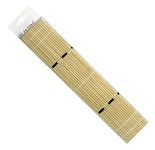
Brush Tubes – A Facepaint UK special, these work best when stored and transported upright, well packed with brushes, or the addition of some sponge to stop them rattling around. The brushes can be left in the tube with the lid off for working, and the lid can come in handy as a spare water pot!
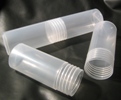
Brush Easels – We have 2 sizes on offer, they protect your brushes in transit, and fold back to form an attractive stand up easel for easy grabbing of that brush. One is taller than the other for longer brushes.
Brush Sleeve – an innovative holder that fits over your wrist. Especially useful for body painters who tend to move away from their equipment more than face painters. (Now discontinued, but maybe you could get creative and make your own?) Here's what it looked like:

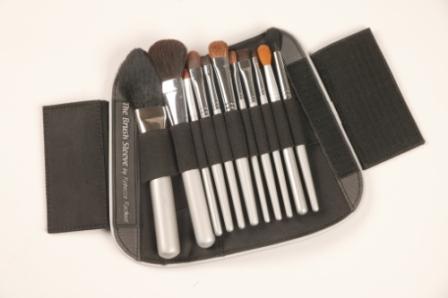
Cleaning
Cleaning is not just essential for hygiene, it is also important in preserving the quality and life of your brushes. DaVinci brush soap is just brilliant
for getting the last bits of paint out of your brushes, and in fact stains out of everything, sponges, practice heads, clothes, the lot! Work the brush
onto the soap in gentle circular movements, and use warm (not over hot) water. The soap also conditions your brushes, remember that natural hair has
natural oils that need replacing just like the stuff on your head. Look here for more information on cleaning and care of your brushes from the daVinci
website. Never leave your brushes head down in water, they will deteriorate quickly and the tips will bend over. This is very difficult to correct.
It is also more likely that the paint will come off the handle and water get into the ferrule with the potential for rotting the hidden base of the
fibres. If your brushes have been damaged you can try leaving them coated with hair gel or soap and formed into the correct shape overnight. Rinse
your brushes gently, in fact treat them as you would a precious friend, and they will become so!
LOOK OUT FOR OUR SPECIAL BRUSH CLEANING KIT!